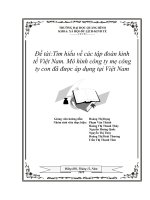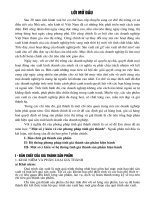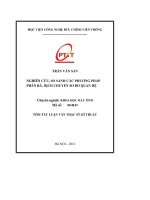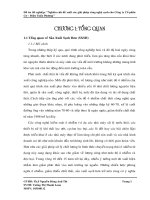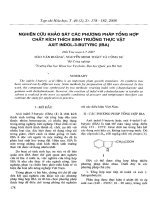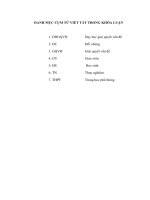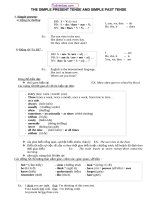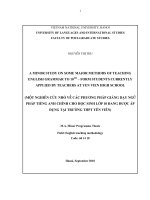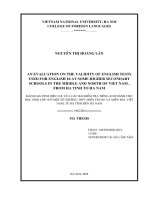Một nghiên cứu nhỏ về các phương pháp giảng dạy ngữ pháp tiếng Anh chính cho học sinh lớp 10 đang được áp dụng tại trường THPT Yên Viên
Bạn đang xem bản rút gọn của tài liệu. Xem và tải ngay bản đầy đủ của tài liệu tại đây (1.45 MB, 81 trang )
1
VIETNAM NATIONAL UNIVERSITY, HANOI
UNIVERSITY OF LANGUAGES AND INTERNATIONAL STUDIES
FACULTY OF POST-GRADUATE STUDIES
NGUYÊ
̃
N THI
̣
THU
A MINOR STUDY ON SOME MAJOR METHODS OF TEACHING
ENGLISH GRAMMAR TO 10
TH
– FORM STUDENTS CURRENTLY
APPLIED BY TEACHERS AT YEN VIEN HIGH SCHOOL
(MÔ
̣
T NGHIÊN CƢ
́
U NHO
̉
VÊ
̀
CA
́
C PHƢƠNG PHA
́
P GIA
̉
NG DA
̣
Y NGƢ
̃
PHP TING ANH CHNH CHO HC SINH LP 10 ĐANG ĐƢƠ
̣
C A
́
P
DNG TI TRƢNG THPT YÊN VIÊN)
M.A. Minor Programme Thesis
Field: English teaching methodology
Code: 60 14 10
Hanoi, September 2010
2
VIETNAM NATIONAL UNIVERSITY, HANOI
UNIVERSITY OF LANGUAGES AND INTERNATIONAL STUDIES
FACULTY OF POST-GRADUATE STUDIES
NGUYÊ
̃
N THI
̣
THU
A MINOR STUDY ON SOME MAJOR METHODS OF TEACHING
ENGLISH GRAMMAR TO THE 10
TH
– FORM STUDENTS
CURRENTLY APPLIED BY TEACHERS AT YEN VIEN HIGH
SCHOOL
(MÔ
̣
T NGHIÊN CƢ
́
U NHO
̉
VÊ
̀
CA
́
C PHƢƠNG PHA
́
P GIA
̉
NG DA
̣
Y NGƢ
̃
PHP TING ANH CHNH CHO HC SINH LP 10 ĐANG ĐƢƠ
̣
C A
́
P
DNG TI TRƢNG THPT YÊN VIÊN)
M.A. Minor Programme Thesis
Field: English teaching methodology
Code: 60 14 10
Supervisor: Phm Th Thanh Thy, M. A.
Hanoi, September 2010
6
TABLE OF CONTENTS
Candidate‟s statement i
Acknowledgements ii
Abstract iii
List of abbreviations iv
List of tables and figures v
PART A: INTRODUCTION 1
1.1. Statement of the problem and rationale for the study 1
1.2. The aims of the study 2
1.3. Research questions 3
1.4. Methods of the study 3
1.5. Significance of the study 3
1.6. Scope of the study 4
1.7. Design of the study 4
PART B: DEVELOPMENT 5
CHAPTER I: LITERATURE REVIEW 5
2.1. What is grammar? 5
2.2. Different views on teaching grammar 6
2.2.1. Whether or not to teach grammar? 6
2.2.2. How to teach grammar? 7
2.2.3. What to teach in a grammar lesson? 8
2.3. Methods of teaching grammar 9
2.3.1. Grammar Translation Method (GTM) 9
2.3.2. The Communicative Language Teaching (CLT) 10
2.3.3. The Task-based Approach (TBA) 12
2.3.4. There is no best method for all? 14
2.4. Issues about how to teach grammar 14
2.4.1. Should we use grammatical explanations and technical terminology in a CLT
classroom? 15
7
2.4.2. Should teachers correct grammatical errors? 15
2.5. Criteria to choose an appropriate method 16
2.6. Criteria to evaluate the effectiveness of teaching methods 16
2.7. Summary 17
CHAPTER II: RESEARCH METHODOLOGY 18
3.1. Research questions and method orientation 18
3.2. Selections of subjects 18
3.3. Research instruments 19
3.3.1. Class observations 19
3.3.2. Questionnaires 20
3.3.2.1. Student questionnaire 20
3.3.2.2. Teacher questionnaire 21
3.3.3. Follow-up interviews 21
3.4. Procedures of data analysis 23
3.5. Summary 23
CHAPTER III: DATA ANALYSIS 24
4.1. Class observations 24
4.2. Questionnaires 26
4.2.1. Student questionnaire 26
4.2.1.1. Students‟ attitudes toward learning English 26
4.2.1.2. Students‟ purposes of learning English 28
4.2.1.3. Students‟ awareness of the role of grammar in reaching their purposes 29
4.2.1.4. Students‟ expectations for a grammar lesson in class 31
4.2.1.5. Students‟ evaluation of grammar lessons in class 32
4.2.2. Teacher questionnaire 36
4.2.2.1. Teachers‟ awareness of the purposes of teaching English at high school and the
role of grammar in reaching those purposes 36
4.2.2.2. Teachers‟ focuses when teaching a new grammatical point 37
4.2.2.3. Teachers‟ reasons for choosing their current teaching methods 39
8
4.2.2.4. Teachers‟ evaluation of their teaching methods 40
4.3. Follow-up interviews 42
4.3.1. Follow-up interviews for students 42
4.3.2. Follow-up interviews for teachers 44
4.4. Summary 46
PART C: CONCLUSION 48
5.1. Summary of the findings 48
5.2. Pedagogical implications 49
5.3. Limitations of the research 50
5.4. Recommendations for further research 51
5.5. Conclusion 51
REFERENCES 53
APPENDIXES I
Transcription of class observation 2 I
Transcription of class observation 3 III
Student questionnaire VI
Teacher questionnaire X
Follow-up interview for students XIV
Follow-up interview for teachers XVII
9
LIST OF ABBREVIATIONS
CLT: Communicative Language Teaching
DM: Direct Method
ELT: English language teaching
GTM: Grammar Translation Method
MOET: Ministry of Education and Training
NA: Natural Approach
Q: Question
S: student
Ss: students
T: teacher
Ts: teachers
TBA: Task-based Approach
YV HS: Yen Vien High School
10
LIST OF TABLES AND FIGURES
Tables Page
Table 1: Students‟ attitudes towards learning English at Yen Vien High School 29
Table 2: Students‟ purposes of learning English 31
Table 3: Reasons why respondents think of the role of English grammar 33
Table 4: Students‟ expectations for a grammar lesson in class 35
Table 5: Students‟ evaluation of the time for communicative activities 39
Table 6: Teachers‟ aims in teaching English to students 41
Table 7: Teachers‟ focuses when teaching grammar to students 42
Table 8: Teachers‟ reasons for choosing the current teaching method 43
Table 9: Factors teachers base on to choose a teaching method 44
Table 10: Teachers‟ evaluation of their teaching methods 45
Table 11: Teachers‟ evaluation of their teaching methods in detailed factors 45
Figures
Figure 1: Students‟ evaluation of grammar lessons in class 36
Figure 2: Students‟ evaluation of the presentation of grammar points 37
Figure 3: Students‟ evaluation of pronunciation teaching 38
Figure 4: Students‟ evaluations of the effectiveness of communicative activities 39
11
PART A: INTRODUCTION
1.1. Statement of the problem and rationale for the study
English language has been the most popular international language for ages. In the new era of
high technology and communication, English is playing a more and more important role and
having a strong impact on many fields of the society. Under this impact, the demand for
communicative competence in English is increasing in every corner of the world.
In terms of teching English as a foreign or secondary language, recent research turns to realize
that the best method never existed and will never exist because teaching situations are
different in all places. As a result, a tailored method rather than a mass-produced one is
required to correspond with them.
To speak about learners, it is notable that the views of learners have changed a lot. Learners
are now recognized as individuals with their own identities, i.e. they are different in
expectations, interests, styles, personalities as well as learning experience. Instead of sitting
passively in classrooms and trying to absorb whatever teachers give them, they have now
become the center of the classroom activities under the widely accepted principle: learner-
centeredness. Accordingly, all these differences among learners have to be carefully
considered before preparing and conducting the classroom activities.
Also, research figures out teachers‟ roles should be changed as well. Instead of being the
controller and informant in class, the teacher now has to play a wide range of roles depending
on the specific situations. With students‟ activeness in class, the teacher now works as a
facilitator, an encourager, an organizer and a guide. In class, student-student interactions, then
student-teacher ones should become the dominant activities in classrooms.
12
To cover all these changes in language teaching within this thesis is an impossible mission. In
this thesis, the author would like to narrow herself by focusing on grammar teaching only in a
high school to find out how the above changes are impacting the teaching and learning
process, what methods are being used to teach grammar and how effective these methods are.
She chose grammar teaching as her focus in this thesis because of some reasons.
First, English grammar has always played the most important role in the Vietnamese context
through the grammar-based university entrance examinations as well as other grammar tests at
school of all levels. Therefore, learners‟ aim of learning English used to be to pass these
important exams. Secondly, many high schools in Vietnam have been criticized for the
teaching methods in which grammar is taught explicitly and then practiced in a huge number
of written grammar exercises without any interaction among students and little between
students and their teacher/s. Teachers have been unique controllers in class. Learners‟ needs,
interests, learning styles, etc. are often neglected. Thirdly, with this thesis, the author hopes to
answer her question on how grammar teaching in Vietnam should be changed to adapt to the
changes of ELT in the world and learners‟ demands. The last reason is related to her personal
profession. As a teacher of English, she has realized that it is really a challenging task to make
grammar teaching satisfactory to students. She has constantly wondered how to deal with
grammar more effectively in classrooms. The answers to this question and the above would be
of great help to the writer as well as to other colleagues.
1.2. The aims of the study
With the presented rationale, the specific aims of the study, accordingly, are:
To investigate how English grammar is currently being taught at Yen Vien High
School and what methods are being used to teach it.
To evaluate the effectiveness of those methods as perceived by teachers and learners at
the school.
To suggest some changes to make grammar teaching much more effective.
13
Among these aims, the second one is the author‟s priority in this research. To achieve this aim,
two other specific objectives were established. The first sub-objective is to find out the
learners‟ English learning expectations and their learning style preferences. These factors are
crucial to affect the effectiveness of grammar learning and teaching and learners‟ evaluation of
the effectiveness. The second is to understand the students‟ and teachers‟ views on the current
grammar teaching methods with the aim of narrowing the gap between grammar teaching and
learning.
1.3. Research questions
To achieve the aims and objectives of the thesis, the following research questions were
proposed: (1) How is grammar being taught at YV High School? Specifically, what methods
are being used to teach grammar? (2) How effective are these methods in the opinion of
teachers and students at YV HS? (3) What can be done to make grammar teaching at YV HS
more effective?
1.4. Methods of the study
To reach the above aims, the study has been carried out with data collected from three
different sources: (1) class observation (2) questionnaires and (3) follow-up interviews. All
these instruments will be described in detail in Chapter 3.
1.5. Significance of the study
It is hoped that the findings from this study will be of some benefits to the teachers in
Vietnamese high schools in general, at YV HS in particular, especially those who are engaged
in grammar teaching. The study contributes to our understanding of the effectiveness of the
current grammar teaching methods based on teachers‟ and learners‟ evaluation and offers
some suggestions of needed changes to minimize the gap between the learners‟ expectations,
interests and the actual practice of teaching and learning.
14
1.6. Scope of the study
As stated above, the study is conducted to find out the evaluations of learners and teachers
towards the effectiveness of the grammar teaching methodologies currently applied in order to
make some methodological recommendations of grammar teaching. The study is, therefore,
explorative by nature. Besides, with the aims of the study, the researcher limited herself to
concentrate on a group of grade 10 students at Yen Vien High School in Hanoi.
1.7. Design of the study
This thesis contains five chapters.
- Chapter One presents the state of the problem and rationale, the aims, the research questions,
the significance as well as the scope of the study.
- Chapter Two prepares the theoretical background for the thesis concerning grammar teaching
methods and criteria to evaluate the efficiency of teaching methods.
- Chapter Three describes in details the methodology underlying the research.
- Chapter Four provides specific description of data analysis, a thorough discussion of the
findings of the study and some recommendations as well.
- Chapter Five is the conclusions.
- The Appendixes are the last part of the study, following the References.
15
PART B: DEVELOPMENT
CHAPTER I: LITERATURE REVIEW
This chapter will present the theoretical background needed for the research by discussing the
definition of grammar, different views of teaching grammar, grammar teaching methods, main
issues in grammar teaching, criteria to choose an appropriate teaching method as well as
criteria to evaluate the effectiveness of a teaching method.
2.1. What is grammar?
It is the fact that there are quite a few different definitions of grammar given by varied
academic schools. However, this study just quotes and discusses two definitions which are
relevant to the research aims.
The first definition is made by Leech G., Deuchar M. & Hoogenraad R. (2005). These authors
consider grammar as a set of rules which allow users of a language to create speech and
writing by combining words together in a meaningful way. Whereas users apply grammar all
the time, they fail to perceive them consciously. Besides, grammar has a very close, interactive
relationship with semantics (meaning), phonology (sounds or speaking) and writing systems.
With this definition, the authors have succeeded in giving a quite complete overview of
grammar as well as highlighting its relationship with other fields of language like semantics,
phonology as well as writing systems. Clearly, people do not use grammar for its own sake,
but use it as an effective tool to express accurately and automatically what they want to
communicate. Nevertheless, whereas this definition is a good one, it limits grammar within the
level of a sentence only. It can be questioned about grammar among the larger units like
sentences, or more.
Brown (1994) approaches grammar in a quite different way. He defines grammar in a larger
unit, not within a sentence but a discourse. In fact, he tries to make clear their distinction.
According to him, grammar is a set of rules controlling the order and the connection of words
16
in the level of a sentence only. The system of discourse rules shares this function, but in the
broader level – among sentences. Brown also emphasizes that grammatical competence is very
important in communicative competence. In fact, the close intercombination between
grammar, semantics and pragmatics form the necessary and sufficient conditions for all
creation and digestion in language. The lack of one of them can make communication fail.
Specifically, grammar helps us construct a sentence, semantics makes that sentence
meaningful and pragmatics enables us to understand the meaning more correctly in a certain
context. The master of this intercombination is crucial in successful language communication.
To sum up, it can be said that the definition of Brown (1994) has covered all the main points
of grammar the other authors discuss. First, grammar is a set of rules or patterns controlling
the sequence and the mutual interaction of words in the level of a sentence only. Secondly,
discourse is grammar but active in the larger units. Thirdly, grammar exists in the close and
interactive relationship with the other factors of a language including semantics, phonology
and the writing systems. Finally, grammar competence is one of the needed conditions for
communicative competence.
2.2. Different views on teaching grammar
Grammar has played a very important role in language teaching for decades. In some places,
teaching grammar is teaching the language. However, with the remarkable change in the needs
of learners and requirements of the new era, a huge amount of research has focused on
grammar teaching to discuss all issues related to it. Different ideas are proposed on teaching
grammar; however, they share in some points.
2.2.1. Whether or not to teach grammar?
Quite a few authors question whether or not to teach grammar. This idea has been actively
discussed for long. Krashen (1983) is the typical author who supports no formal grammar
teaching in class. He claims that language should be acquired through natural exposure and
comprehensible input. Even though Krashen‟s Natural Approach has great contributions to the
17
teaching and learning process, it has been criticized for fossilized non-standard variants of the
target language. However, all in all, with the legitimate arguments and the experience of a
teacher, Brown (1994) confidently states that judicious attention to grammatical form in the
language learning classroom is not only helpful if appropriate techniques are used, but also
essential to a speedy learning process.
2.2.2. How to teach grammar?
The next issue which is widely discussed by numerous authors is how to teach grammar.
Specifically, ideas focus on whether to teach grammar explicitly (or deductive or overt
grammar teaching) or implicitly (or inductive or covert teaching) and whether to follow
learner-centered or teacher-centered approach.
According to implicit approach, the students are presented with examples first and then they
are guided to figure out the rule or generalization from the examples. A clear grammar
explanation may never be given from their teacher. Explicit one is different because in this
approach, a rule or generalization is first given by the teacher or textbook and then students
are allowed to practice various instances of language to which the rule applies (Brown, 1994).
Many authors (Brown, 1994; Hartnett, 1985; Gardner, 2008, etc.) discuss this issue and agree
in some points. First, generally, an implicit approach is more in favor because it allows
students to discover some aspects of language before getting to know grammatical
explanations so that it builds more intrinsic motivation among them. However, in some cases,
an explicit approach or a blend between the two is more appropriate. In fact, the distinction
between these approaches in a lesson is not always apparent. All in all, the choice should
depend on specific teaching contexts.
The learner-centered approach‟s principle is that the emphasis in the teaching and learning
process at all times should be on the learner, not the teacher (Stevick, 1982). Stevick also
notes that learner-centeredness does not imply that teachers should abandon the classroom to
18
the learners, and that there should be a number of legitimate teacher functions in learner- as
well as teacher-centered classrooms.
After a large amount of research, authors come to a conclusion that whereas students prefer
moving from teacher-centered to more learner-centered class, they still think both of these
approaches are useful. All in all, it is a good idea for teachers to make use of all these
approaches to satisfy students.
2.2.3. What to teach in a grammar lesson?
Another hot issue related to grammar teaching is what to teach in a grammar lesson, i.e. we
should focus on forms or functions or any others.
According to Harmer (1987), language is used actually to do things, to perform certain
functions, like inviting, apologizing, introducing and so on. Therefore, instead of teaching
grammar, teachers should teach functions to students even though their grammatical base
should be insured as well. Clear evidence is that modern courses often teach a grammatical
structure and then get students to use it as part of a functional conversation.
Freeman (2003) shares Harmer‟s ideas to some extent. However, she asserts that teaching
grammar includes teaching form, meaning and use as well. She clarifies that teaching those
three dimensions is really important because it will make students have enough knowledge to
reach the primary goal of learning a language which, after all, is to enable to communicate in
the target language. However, she also notes that language functions might be emphasized
over forms (Freeman, 2000).
In short, authors confirm the necessity of teaching grammar to student, because if appropriate
techniques are used, grammar can effectively assist students in the learning process. To help
learners communicate well and appropriately in the target language, it is necessary that
teachers teach them the form, meaning and use of any grammar. The exclusion of any
19
dimension can badly affect students. As a teacher, we can choose any method or a
combination of some to serve best our students‟ interests, needs, personalities and experience.
2.3. Methods of teaching grammar
First, what is method? Generally, method is “a way of doing something” (Cambridge
Advanced Learners‟ Dictionary, 2003). Pedagogically, method is overall means of achieving
the general objectives of a course via conducting a set of procedures, techniques or activities
(Johnson & Morrow, 1981). Method is often mistaken with the other terms – approach and
methodology. However, their distinction is quite ambiguous and vague. Therefore, it should be
unnecessary to try to distinguish them (Canh, 2004). The writer would use these terms
interchangeably in this thesis as a result.
A large number of different teaching methods fell in and fell out of fashion in the process of
searching for the best method for all. In this thesis, the author presents only relevant methods
to get the firm background for the research. With each method, the characteristics, the
strengths as well as the limits relating to grammar teaching will be discussed (the author‟s
emphasis).
2.3.1. Grammar Translation Method (GTM)
According to Brown (1994), the first dominant teaching method is grammar translation one. It
is based on the principles that languages are not being taught primarily to learn oral/ aural
communication but to learn for the sake of being scholarly.
Its main features are indicated very clearly by Prator and Celce-Muricia (1979) as classes are
taught in the mother tongue with little use of the target language; long elaborate explanations
of the intricacies of grammar are given; and instructions often focus on the form; little or no
attention is given to pronunciation. Besides, in GTM, the teacher is the authority in classrooms
and it is very important that students get the correct answer. Most of the interaction in the
20
classroom is activated by the teacher to the students and there is little student initiation and
little student-student interaction (Freeman, 2000).
Two main drawbacks of GTM are no help to students‟ communicative ability in the target
language and the sluggishness in updating language skills and other knowledge among
teachers (Brown, 1994). Moreover, GTM seems to badly affect learners‟ motivation due to
compulsory memorization of endless lists of unusable grammar rules (Richards & Rodgers,
1986). However, the fact is that this method is now still used widely because it allows teachers
to be lazy to work hard. It is also much easier to design and more objective to mark a test on
grammar and translation than on other language skills.
2.3.2. The Communicative Language Teaching (CLT)
CLT can be said to be the current dominant methodology (Brown, 1994: 77). It starts with a
theory of language as communication, and its goal is to develop learners‟ communicative
competence. Communicative competence means knowing when and how to say what to whom
(Canale & Swain, 1980). It includes four dimensions existing in the close inter-relationship:
grammatical, linguistic, discourse, and strategic competences. This relationship asserts the
necessity of grammar to become proficient in communication.
Based on the research of Li (2001), Nunan (1991a: 279) and Freeman (1986), CLT is
characterized by: its focus on communicative functions, on meaningful tasks rather than on
language (e.g., grammar or vocabulary study) even though learners still have chances to learn
about the language; tasks and language relevant to a target group of learners; a lot of
interactions in the target language via the use of group activities and pair works; a secure, non-
threatening learning atmosphere; learner-centeredness and material choices based on students‟
needs.
Harmer (2001) specifies CLT‟s features with the two terms „what to teach‟ and „how to teach‟
In terms of „what to teach‟, CLT stresses the significance of language functions rather than
language study. A guiding principle is to train students to use these language forms
21
appropriately in a variety of contexts and for a variety of purposes. The „how to teach‟ aspect
of CLT is closely related to the idea that it is plentiful exposure to language in use and plenty
of opportunities to use it are vitally important for a student‟s development of knowledge and
skill. Activities in CLT typically involve students in real or realistic communication, where the
accuracy of the language they use is less important than successful achievement of the
communicative task they are performing.
Concerning learners‟ and teachers‟ roles in CLT, learners are expected to be much more active
in the interaction with their own learning, their partners, teachers and materials (Nunan, 1989).
The roles of teachers are also more varied than in the past. Instead of being the knowledge-
giver and unique controller in classes, they are now organizer, guide, facilitator of the
communication process, participant within the learning-teaching group, researcher-learner
(Breen and Candlin, 1980) and „need analyst‟ (Nunan 1988).
CLT has left an indelible mark on teaching and learning, resulting in the use of communicative
activities in classrooms all over the world (Harmer, 2001). It is proven that this method can
help develop learners‟ communicative skills in the target language, enhance their confidence
as well as their motivation in the learning process.
Apart from the above strong points, CLT also has some shortcomings. First, CLT demands a
relatively uncontrolled range of language use on the part of the student, and expects the
teacher to be able to respond to any language problem which may come up. This is really a big
challenge for non-native teachers whose spoken English, strategic and sociolinguistic
competences are still limited. Second, that CLT mainly focuses on fluency over accuracy
meets the resistance from teachers and students in places where grammar-based testing system
is still popular (Harmer, 2001; Defeng Li, 2001). The last but not least hindrance comes from
learners. Their low English proficiency, little motivation for communicative competence and
resistance to class participation into non-traditional pair work and group work activities keep
22
them refusing to accept CLT. Some other conditions of the environment like large classes,
testing system and education policy are also unfavorable to CLT.
2.3.3. The Task-based Approach (TBA)
Among recent manifestations of CLT, task-based instruction has emerged as a major focal
point of language teaching practice worldwide.
First, what is task? Task is simply “an activity which requires learners to use language, with
emphasis on meaning, to attain an objective” (Skehan, 2003: 3). Task-based learning is not a
new method. Rather, it simply puts a set of communicative tasks at the center of one‟s
methodological focus.
David Nunan (1991a: 279) gives us some characteristics of a task-based approach to language
teaching: emphasis on learning to communicate through abundant interaction in the target
language; use of authentic texts in the learning situation; attempt to link classroom language
learning with language activation outside the classroom. Teachers‟ roles are also the same as
their roles in CLT above.
With regards to basic stages of the Task-based methodology, Willis (1996: 52) suggests three
stages: the Pre-task, the Task cycle, and Language focus. In the Pre-task, the teacher explores
the topic with the class and may highlight useful words and phrases, and helps students to
understand the task instructions. During the Task cycle, the students perform the task in pairs
or small groups while the teacher monitors from a distance. The students then plan how they
will tell the rest of the class what they did and how it went, and they then report on the task
either orally or in writing. In the Language focus stage, the students examine and discuss
specific features of any listening or reading text which they have looked at for the task and/ or
the teacher may conduct some form of practice of specific language features which the task
has provoked.
23
Clearly, to complete a task, students have to interact with their partners. Such interaction is
thought to facilitate language acquisition as learners have to work to understand each other
and to express their own meaning. By so doing, they have to check to see if they have
comprehended correctly and, at times, they have to seek clarification. Also, they get to listen
to language which may be beyond their present ability, but which may be assimilated into their
knowledge of the target language for use at a later time (Candlin & Murphy, 1987:1).
At first glance, CLT and TBA may not seem so different. However, while the task in CLT
lessons is to get students to practice a communicative function, the task-based lesson does not
focus on a particular function or even a particular form of the language but a wide variety of
linguistic forms at the same time to conduct the task (Long 1989).
Prabhu identified three types of tasks in TBA: information-gap activity, opinion-gap activity
and reasoning-gap activity. Information-gap activity involves the exchange of information
among participants in order to complete a task. Opinion-gap activity requires that students
give their personal preferences, feelings, or attitudes in order to complete a task. A reasoning-
gap activity requires students to derive some new information by inferring it from information
they have been given.
TBA shows its outstanding strength to develop learners‟ communicative skills through
meaningful tasks. With TBA, learners are believed to increase needed competence for
successful communication. However, critics of TBA have worried about its applicability to
lower learning levels. They also add that tasks should not be considered as the basis for an
entire pedagogical methodology because the kind of interaction which typical tasks promote
leads to the use of specific „task-solving‟ linguistic forms rather than the kind of language
expected from discussion, debate, or social interaction of other kinds.
24
2.3.4. There is no best method for all?
For much of its history, language teaching has been obsessed with a search for the „right‟
method which would work for all learners in all contexts (Richards 1987). More recently, it
has been realized that that ideal method would never be the case because there are important
variations in the teaching context that influence what is best.
However, there still exists a relative best method for a specific situation and “it all depends,”
(Prabhu, 1990:162-163). Candlin (1991) shares Prabhu‟s ideas and adds that only the teacher
can decide which is the best method for his/ her own situation by choosing the best of what
others have experienced with and adapt or tailor it to his/her own situation.
Hilles (1988) proposes another idea for this situation. Based on her research, she concludes
that it is probably the case that students do best in classes in which the teacher varies the
approach in order to accommodate all learning styles. To prevent this lack of differentiation,
she supports an approach to teaching grammar which encourages learners to use their eyes,
their ears, and as many of the other senses as possible. She continues that if a certain grammar
instruction seems appropriate for a class, the teacher‟s next step is to integrate grammar
principles into a communicative framework, since communication is the fundamental purpose
of language. In other words, grammar points should be taught and practiced in realistic and
effective contextualization to provide students a whole picture of English and enable them to
apply what they have learned in actual situations better, even though this task is not always
easy.
2.4. Issues about how to teach grammar
There are many issues about how to teach grammar, but in this study, just two main ones are
listed.
25
2.4.1. Should we use grammatical explanations and technical terminology in a CLT
classroom?
Brown (1994) also warns English teachers to be very cautious to explain grammar and its
terms, or else they will make their students more overloaded with complicated knowledge.
However, he emphasizes that if they give grammatical explanation skillfully, their adult
learners can find it very useful.
Haycraft (1992) suggests one tip to help teachers work out explanation effectively. The tip is
that if there is a point a teacher wishes to explain to his/ her students, try to work it out for
himself/ herself by deductive analysis first. Specifically, he/she should base on typical
contrasting examples to think of explanations and make sure the explanations are easy for
them to understand. Then, teachers should try to involve their students in that process of
deduction as well. If doing so, learners will understand the point more clearly. Teachers
should let students look at the examples and find out the difference. The more teachers involve
students, the more motivated they will be.
2.4.2. Should teachers correct grammatical errors?
For this issue, Brown (1994) also discusses the two sides of the problem. He concludes that
teachers should pay attention to and help students overcome grammatical errors, but in a
tactful way so that students‟ communicative flows are not interrupted. Li (2001) agrees with
Brown but warns that teachers should make grammar the end of their teaching to prevent
learners‟ communicative activities from being interrupted.
It should also be noted that learners will never truly attend to form unless they want to and are
able to. They will learn best once they have achieved basic comprehension and can accept
feedback on the form of their production in meaningful discourse, either spoken or written. In
other words, feedback on form becomes more important after the student has acquired
minimal competence and can absorb this feedback (Marianne Celce-Murcia Sharon Hilles,
1988).
26
2.5. Criteria to choose an appropriate method
Stevick (1982) and Candlin (1991) argue that success or failure in language teaching depends
not so much on whether one adopts inductive or deductive techniques for teaching grammar,
or whether one engages in meaningful practice rather than in pattern drills, but in the extent to
which one caters to the learner-related factors. Therefore, if a method is chosen, it should
encourage learners to adopt the right attitudes, interests and motivation in the target language
and culture, as well as in the learning environment in which they find themselves, and then
successful learning will occur. In contrast, if these affective factors are not right, then no set of
techniques is likely to succeed.
The factor proposed above seems to be quite abstract whereas it is extremely difficult to
conclude which approaches and methods are most appropriate for one‟s own teaching
situations. To make this process easier, based on common conclusions of other research,
Harmer (2001) creates very clearly a list of important elements including constant exposure to
language; comprehensible input and some conscious language study to help students
remember language facts; application of CLT and TBA as a key part of teaching process to
offer real learning benefits together with some other supplementary methods; relaxing learning
environment for learning to take place; chances for students to discover the language
themselves for better retention in the long run; teaching grammar and lexis semantically and
pragmatically; and the harmony between methodology and learners‟ culture. Harmer also
reminds teachers that they should use up all these flexibly to decide what and how to teach,
especially, what seems to work in their own contexts.
2.6. Criteria to evaluate the effectiveness of teaching methods
Effectiveness is a state when you “successfully achieve the results that you want” (Cambridge
Advanced Learners‟ Dictionary). Therefore, in order to evaluate the effectiveness of teaching
methods, it is necessary to find out the results the teaching and learning process wants to
achieve, then compare between these results and the actual achievements of teachers to see
27
how much they met. In teaching, those results exist in the form of aims set by educational
institutions and expectations of the learners.
In this study, the author concentrates on finding out the goals of the teaching which are set by
MOET (Ministry of Education and Training), the needs and interests of the learners, the
teaching methods currently applied and then evaluating whether or not those goals are met.
2.7. Summary
This chapter has covered theoretical background needed to support the study. That background
includes the clear definition of grammar, noticeable views of grammar teaching, some relevant
grammar teaching methodologies, considerable issues related to this issue, criteria to choose
an appropriate teaching method as well as to evaluate the effectiveness of one method. The
next chapter describes the research methodology in detail.
28
CHAPTER II: RESEARCH METHODOLOGY
This chapter presents a detailed description of the research methodology the author chose for
the achievement of the aims and objectives of the study and the data collection and analysis
procedures.
3.1. Research questions and method orientation
As stated in 1.3, this study was designed to seek answers to the following questions: (1) How
is English grammar being taught at YV High School? Specifically, what methods are being
used to teach English grammar? (2) How effective are these methods as perceived by teachers
and students at YV HS? (3) What can be done to make English grammar teaching at YV HS
more effective? The answers to these questions would help us realize the current changes in
terms of grammar methodologies as well as its gap in comparison with learners‟ needs and
interests.
To give the best answers to these questions the author employed both qualitative and
quantitative data analysis methods. The combination of the two is believed to gain deeper data
for analysis.
3.2. Selection of subjects
This study was carried out with three 10
th
classes at Yen Vien High School in Hanoi. Each
class has 50 students, both male and female. They all have studied English since grade 3 and
followed the new English textbook series applied by MOET (Ministry of Education and
Training) since they were in grade 6. The new textbooks were expected to incorporate the
latest methodology in second language teaching – CLT with task-based approach and learner-
centeredness (Hoang et al 2006). Also, these 3 classes are taught by Vietnamese teachers of
English.
